Imagine if you brewed a beer, left it on a shelf for four months and just remembered it now? Imagine if the shelf in question was in a working kitchen, with temperatures rising over 35C? And imagine if said beer was unfiltered and unpasteurised?
There are those who believe that, since the cold chain has been broken, since control over the storage conditions has been lost, this beer will probably no longer be drinkable. For example, there are brewers who refuse to ship their beer to other parts of the country, or refuse to attend festivals more than a few hours’ drive from their brewery, believing that their unfiltered, unpasteurised, and often bottle-conditioned beer will change beyond recognition if it sits out of a fridge for a day. There are brewers who, when you tell them that you tried their beer and it was sour/phenolic/just plain off, that it was because the beer “doesn’t travel well”. Indeed, there have been many times where I have tried a Cape Town beer in Johannesburg (and vice versa) which does not live up to the quality of that beer at its source.
So is it true? Should beer be treated like milk and can it not travel well?
Recently, the brewers at The Craft Beer Project (by which I of course mean my hubby Shawn and our buddy Greg) have begun to attempt to brew all the styles of the BJCP guidelines. Their first brew, an Ordinary Bitter (imaginatively named “8A”), was brewed in July 10th, 2014 and bottled on August 3rd, carbonated with CO2 using a Blichmann bottle gun. To test the cleanliness of the brewery and see if there were any infections lurking, the brewers decided to leave a few bottles out of the fridge and let them age in the heat. Beer, like any natural product, will age more quickly in hotter conditions – think about how much faster fruit ripens when left out of the fridge.
Professor of Malting & Brewing Sciences and all-round beer guru Dr. Charlie Bamforth has done plenty of research into the topic of how temperature affects the rate that beer gets old and found that beer ages twice as quickly when you raise the temperature by 10 degrees. I’ve heard others say that beer aged at 30 degrees C for 30 days ages roughly the same as beer aged at three degrees for 365 days. So, the ordinary bitter, which was sitting on a top shelf in Banana Jam Café’s kitchen for close to four months, would have be the equivalent to being left in a fridge for close to four years. According to the logic above, this beer should be awful.
It wasn’t. That said, it was not what it was several months ago. As beer ages, the flavours and aromas of the product will change – one of the major reasons for larger breweries using pasteurisation is to delay this change, thus keeping their beer tasting the same for longer. Most microbrewers don’t have this luxury, but this isn’t necessarily a disadvantage. Beer that has aged does not automatically give off-flavours and research shows that many consumers actually enjoy the flavours of an aged beer. The bitterness drops substantially in aged beers, partly because of the rise of sweet and toffee-like flavours. Additionally, the beer might take on a cardboard/sherry type of flavour because of oxidization, creating a complex bouquet of flavours, especially in dark beers (for more nerdy information on how beer ages, check out this article.
The Ordinary Bitter reflected this – the bitterness was gone and it was noticeably sweeter, as well as slightly more carbonated. There was no sourness, no band aid flavours and it did not gush. An aged beer should not exhibit these qualities – only in a beer that had an infection to begin with would this happen. Hence the importance of santization, as well as quality control (in the brewery and in the – pub good sanitation is needed throughout the life of the beer).
If you leave your beer at room temperature for a month and, upon opening, are struck in the face with plasticky smelling vinegar that gushes like a volcano, you have an infection. It is not that the beer hasn’t aged well, it’s that it wasn’t made well. The beer took on off-flavours because there was bacteria present in the beer (either from the brewing, fermentation or bottling process) and, as the beer aged, this bacteria grew, giving the noticeable off-flavours. Many times this off-flavour may not be present at the source, as the beer was kept cold, delaying the growth of the bacteria. So while it was the travel that sped up the growth of the infection, it was not the travel that caused the beer to go off – that was the fault of bad sanitation.
At the end of the day, we all want to drink a wide variety of amazing tasting beer brewed in South Africa. There is no reason I shouldn’t be able to go to a Cape Town liquor store (even on a Sunday – whoop to longer opening hours!) to buy a craft beer that’s been brewed on the other side of the country without worrying that the beer hasn’t “travelled well”. As the craft beer industry grows, so do the expectations and knowledge of the consumer who is always wanting more and better beer and, much like sanitation, it is up to the brewer to deliver.
Have you ever tried ageing beer? How did it taste? Have you bought a beer that “did not travel well”? Do you think the cold chain needs to be maintained? Or do you agree that if a beer has been made well, it won’t suddenly turn into a bottle of band aids and goop?

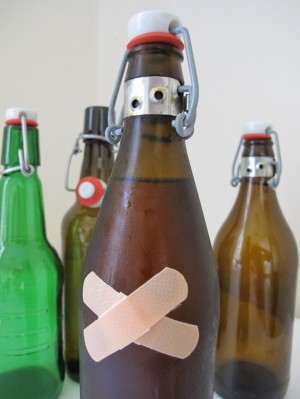
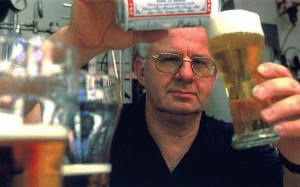
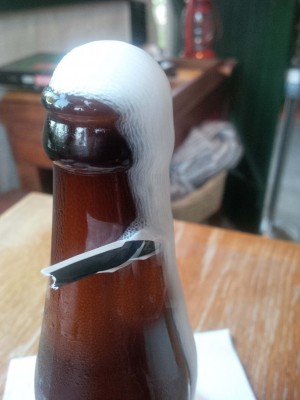




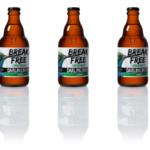



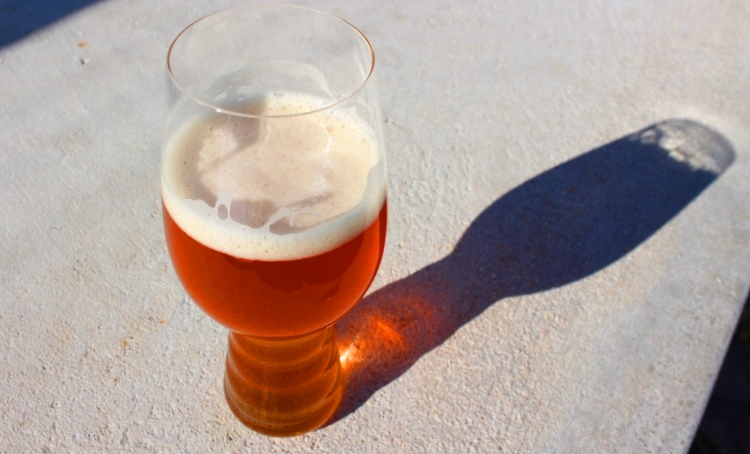
LOVE this article. A topic that there is much debate about. I have had beers (usually forgotten) sit in the uni cold room that regularly broke, so there was a lot of 10 degree to 25 degree shifts over a space of 2 years (at least). On cracking those beers open, there was absolutely nothing wrong with them, just a lowered bitterness, smoother, more rounded flavour, and on my roasty beers, a decrease in roast-related-sharpness. It didn’t seem to do any harm having those fluctuations over time. I reckon a consumer would merely say it was slightly different from a younger batch. But I think that is what adds charm to a bottle conditioned beer. Much like the true cask-ales with hand pumps, they were expected to change over time, which “forced” you to the pub to enjoy that beers gradual morphing. I love tasting how beers change over time. I think the “Bottled-on-date” on the bottle is very important on bottle-conditioned beers. At least then we know why this double IPA is lacking some hop aroma and bitterness if it was bottled 6 months ago.
I also took some old beers home from an previous years intervarsity competition that I wanted to empty out to re-use the bottles, thinking that those beers were probably old and decrepit by that stage. I left them outside in their crate in the summer sun for 2 days (probably reaching 35 degrees) (it didn’t matter as I was throwing them away anyway). For sh*ts and giggles, I popped a couple in the fridge to taste. I ended up drinking all of them over the following few days as they were all really tasty (the crate must have protected the beer from the sun sufficiently to avoid skunking). No off flavours or aromas that I could pick up, and no gushers.
In my opinion, beers that are off have to have had that contamination in the bottle prior to capping. Travel just allowed it to grow sufficiently to cause a noticeable problem. Of course, there is no way of completely preventing a microbe sneaking into a bottle, and I have experienced this often when buying bottled beers at a pub. Only yesterday did I go out for a beer, a South African craft beer that is considered “mass-produced” in the eyes of craft brewing in SA, and one that I can consistently rely on to be great. One bottle had a nasty ring around the top, and was slightly murky and very fizzy. It tasted okay, but not the beer I know so well, there was something lurking in the background. On trying a second bottle, it was perfect. We need to remember that even the large commercial breweries that spend millions on nifty systems, get it wrong sometimes. But I think we need to forgive the odd bottle that slips. If entire batches are bad, then it’s a different story.
Sanitation sanitation sanitation!
I love it when your comments are almost as long as my blog posts Megan! 😉
Very, very good point re including a “bottled on” date – I really hope this is something we see more of in SA this year. It’s also useful for tracing things back to see if it was a bad batch or just a bottle that slipped through the sanitation net…
In the third last paragraph you mention ” ….as the beer was kept cold, prolonging the growth of the bacteria.” Shouldn’t it be “delaying the growth”?
I do not have enough fridge space to age my beers in the fridge, so they end up in a dark cupboard. Am I just ruining my precious beers, or is darkness and a cool environment enough? The beers that I am aging are beers that can be aged (Triple, Double, Geuze, etc).
Whoops – thanks Mr Seige. I have changed the wording accordingly!
I also store my beers in a cool, dark cupboard and personally, I think this should be enough…
Very good info thanks.
Thanks Roeks!
I agree that generally off flavours will be a result of something wrong during the beer making process. I think it is most likely during the bottling process as you wrote about last year. But exposure to light, especially but not only sunlight, can turn a well made beer bad.
On ageing, and this is based on my less than 2 years of brewing experience (and only bottling conditioning) I think it is simple: darker, higher alcohol beers age better. Aroma flavours from hops disappear after 3 months.
I have made three different stouts. One is less than 4% and it starting getting worse after about 5 months, my next is about 5.5% and it seems to still be improving after 5 months (but probably at its prime), the next is 7.5% and is just amazing after 11 months.
You make very good points Jonathan, especially re the type of beers that age well. A lot of the US IPAs we’ve tasted over here have been perfectly great beers, but the hop aromas in particular disappear after a while…
As a home brewer I always aged a portion of each batch for at least 3 months (usually 6) at room temperature (anything up to 35C in summer). Yes the beer changed, sometimes it got better, sometimes worse (hop flavour sometimes disappeared); but apart from the beginning when I was still learning, they were not gushers or otherwise off. Hopefully this continues as I move into pro brewing, but if it doesn’t I’m not going to say my beer doesn’t travel well, I’m going to figure out what went wrong IN THE BREWERY!
Does the cold chain need to be maintained? Sure, if you are wanting to drink the beer the way it was truly meant to taste. But if the beer was made well with good sanitation, it’s not going to suddenly go bad, it’s just going to age.
Thanks Dion – weren’t we going to do a test – keep a case in a cupboard and open one a month??
So true, Lucy
I have beers in my cellar that have been at room temp for 2+ years at anything from 10-30 degrees throughout the year. Aside from some occasional oxidation they are all still very drinkable beers.
Thanks David 🙂
Some pedantic brewer comments: beer does not become “infected”, rather “microbially contaminated”.
The off flavour you associate with band aids is 4VG – brewers should learn to use the correct nomenclature lest we become aligned with all the bollox wine makers spew forth!